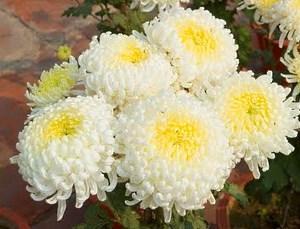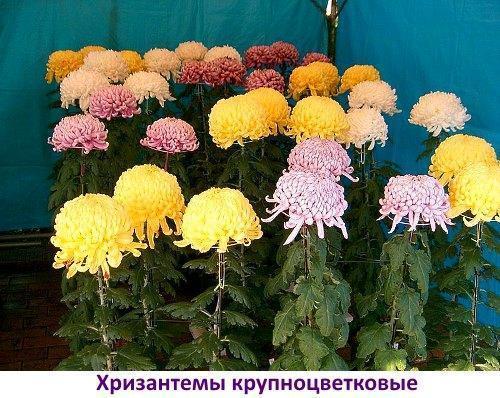Growing chrysanthemums at home is available to everyone
 Chrysanthemums are one of the favorite plants of flower growers. This is due not only to their beautiful decorative appearance, but also to their relatively easy care. They decorate any flower garden until late autumn.
Chrysanthemums are one of the favorite plants of flower growers. This is due not only to their beautiful decorative appearance, but also to their relatively easy care. They decorate any flower garden until late autumn.
Fine chrysanthemums (cultivation and care)
Growing chrysanthemums is not difficult even for inexperienced growers. Well-lit areas with fertile soil of average mechanical composition are suitable for them. The soil should not contain excess organic fertilizers. When choosing a place for chrysanthemums, remember that they do not tolerate stagnant water. This plant is distinguished by its cold resistance and drought resistance.
Chrysanthemums reproduce by cuttings and division of mother liquors. Recently, the method of growing these flowers by sowing seeds in open ground and for seedlings has become increasingly used. Most often, this breeding method is used to breed rare varieties of chrysanthemums. Some experienced florists grow flowers by sowing seeds before winter.
Chrysanthemums are considered quite resistant plants to diseases and pests, but despite this, they can be affected by:
- Powdery mildew, a sign of which is a white powdery coating on all parts of the plant. This disease requires the introduction of a sufficient amount of phosphorus and potassium fertilizers, regular removal of old leaves and sub-root watering without moisture entering the leaves.
- Nematodosis, in which light spots appear on the leaves, limited by veins. Then they turn black and dry. Control methods: soil treatment with steam, disinfection with formalin or carbothion. Sick bushes are kept in hot water (55 ° C) for 5 minutes. After this treatment, they are planted in disinfected soil.
- A field or meadow bug that feeds on plant juices. Control methods: spraying with various insecticides ("Karbofos", "Decis", "Fury").
- A spider mite that damages the leaves from the underside. Control methods: spraying with "Karbofos".
The following forms of chrysanthemums are grown in flower beds:
- Small-flowered, which have many shoots, crowned with numerous (up to 800 pcs.) Small inflorescences, 2-9 cm in diameter.
- Large-flowered, reaching a height of 1-1.2 meters. On their stems there are 1-10 large inflorescences.

Some growers use the biological characteristics of certain varieties of chrysanthemums to grow them in the winter under indoor conditions. To obtain flowering plants in January-March, late-flowering varieties with a budding period of 12-14 weeks are used. This method of growing chrysanthemums is very costly as it uses additional lighting.
How to grow chrysanthemums from seeds in your area?
The cultivation of annual and perennial chrysanthemums has recently become more and more popular. They can be obtained by sowing seeds in open ground in late April or May. On the prepared beds, holes are made at intervals of 20-25 cm. Fill them with warm water and put 2-3 seeds each. The holes covered with earth are covered with a garden film. Thanks to it, the soil in the hole will be well warmed up and moistened, which contributes to the fastest germination of seeds.

 When the first shoots appear, the shelter is removed. Caring for the young chrysanthemums consists in regularly loosening the soil, removing weeds and applying top dressing.A week after germination, they can be fed with liquid fertilizer, highly diluted with water. For this, drugs such as "Rainbow" and "Ideal" are suitable.
When the first shoots appear, the shelter is removed. Caring for the young chrysanthemums consists in regularly loosening the soil, removing weeds and applying top dressing.A week after germination, they can be fed with liquid fertilizer, highly diluted with water. For this, drugs such as "Rainbow" and "Ideal" are suitable.
When the seedlings reach 5-10 cm in height, one plant is left in the hole. For this, the strongest specimens are chosen. The rest of the seedlings can be carefully removed from the ground and planted elsewhere. Chrysanthemums bloom 40-50 days after the seedlings appear.
Growing chrysanthemums from seeds using seedlings
Growing chrysanthemums from seeds can also be done through seedlings. In this case, flowering occurs much faster. Perennial chrysanthemums are grown only in this way. In February-March, seeds are sown in small boxes filled with nutritious soil. For its preparation, in equal proportions, you can take soil from a greenhouse, humus and peat. Before sowing the seeds, the soil mixture is sieved and steamed at a temperature of about 120 ° C. Ready-made soil for flowering plants is also suitable for seedlings.
Drainage must be poured at the bottom of the boxes (expanded clay, small stones, broken red brick). Wet soil is poured on top of it. Seeds are poured onto its surface.
At the same time, there is a strict rule for their termination:
- the seeds of annual chrysanthemums are sprinkled with a layer of soil of 0.5 cm;
- seeds of perennial varieties are left on the surface of the soil, only by pressing them with the palm of your hand.
The earth is moistened with a spray bottle. The boxes are covered with plastic wrap. They are placed in a warm place where the temperature is 23-25 ° C. Crops are regularly checked, moistened and aired. The soil should not dry out. After 10-14 days, seedlings appear. After that, the boxes with seedlings are placed in a bright place.
When 2-4 leaves appear, the plants dive into cups or pots. This will protect the chrysanthemum root system from damage during transplantation. Seedlings that are very elongated and weakened are not suitable for diving. After completing this procedure, the plants are sprayed with a solution of "Zircon" or "Epin-Extra". These drugs help seedlings take root faster.
Caring for young chrysanthemums is simple. It consists in maintaining an optimal temperature of 16-18 ° C, regular watering and feeding. Plants are fertilized once every 2 weeks. In case of insufficient natural light, you may need additional. With proper care, seedlings reach 15-20 cm in height in 1.5 months. When the air outside warms up to 15-18 ° C, the plants are transferred to the greenhouse. After the end of the threat of spring frosts in May, chrysanthemums are planted in a permanent place. Immediately after landing on the flower beds, the tops of the seedlings are pinched. When the lateral shoots reach a length of 15-20 cm, the pinching is repeated. Thanks to this procedure, dense, compact bushes are obtained, strewn with numerous inflorescences.
Cutting and dividing the chrysanthemum bush
The main way of reproduction of chrysanthemums is considered vegetative - cuttings. The breeding process begins with the selection of the best mother plants. After flowering, they are dropped in greenhouses or planted in boxes and left in a cool, dry place with normal lighting. Then vernalization is carried out - the content of mother liquors at a temperature of 1-4 ° C for 2-4 weeks. Then they are brought into a warm, well-lit room. After that, root shoots begin to actively grow on the mother plants. It is cut into cuttings when 2-3 internodes are formed. They are planted in prepared boxes. The optimum temperature for their development is 16-18 ° C.

Reproduction by dividing the bush is less productive, but the easiest. Small-flowered chrysanthemums are most often used for division. The bushes are transplanted after 2 years, dividing them into several parts with young shoots.
I love chrysanthemums very much, their indescribable aroma. I also consider chrysanthemum to be the queen of the flower garden.This is especially true in late autumn, when all spring-summer flowers have withered, and the chrysanthemum is still fragrant. I have been growing them for a long time. I have many varieties. These flowers are not picky, they do not require special care. I propagate them by dividing the bush. For the winter, I dig it out of the flower garden and plant it in pots. In the spring, when the soil warms up, I plant it back in the flower garden, while I divide the bush into several parts. A very simple way. Sometimes I also use the grafting method. But I never tried to sow chrysanthemums with seeds. Thanks for the advice.
I completely agree with you, in autumn they bloom until frost and even after -3 if you cut off the branches for a long time they stand at home in a vase. Beautiful flowers. I don’t dig them up for the winter, they winter on the street (near Tyumen) and there were frosts below -40, they survive without any special shelter. But I tried to dig out for the winter, something didn't work out for me, I died in the spring (though I cut it off and let it down to the basement, maybe this is a mistake?) / This year I planted houses with cuttings in the winter - let's see what happens, some the twigs are alive.
Thank you very much for the advice. I am a beginner gardener. The seedlings have thin legs, I don’t know what kind of feeding is needed. The cuttings have begun well.